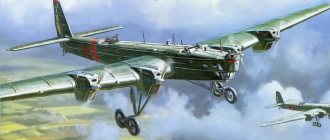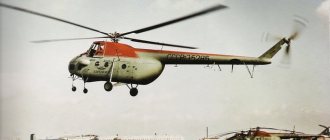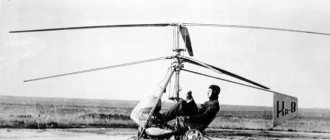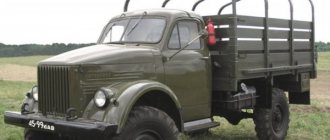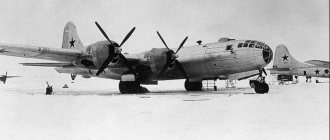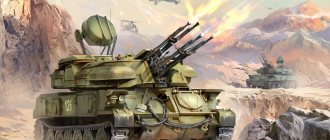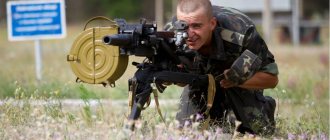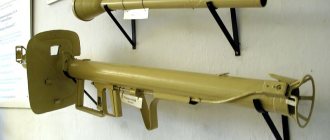When the experimental I-26 - the ancestor of the serial Yak-1 - was being tested, it is unlikely that anyone could have foreseen what a glorious fate was in store for this aircraft. The prototype failed state tests twice, did not show the declared characteristics, its design was constantly being improved, but aircraft factories could not keep up with these improvements.
But in the end, Yakovlev’s plane turned out to be so good that it did not lose its combat value even until 1945. And if the modernized Yak-3 had retained the name Yak-1M, then it could be argued that the “unit” was generally one of the best fighters in the world.
History of creation
Until the end of the 30s, Alexander Yakovlev did not build combat aircraft. Light multi-purpose airplanes and racing aircraft, produced under the AIR brand, were considered his “patrimony”. However, in 1939, he unexpectedly built and introduced the BB-22 high-speed bomber. At the May Day parade, the BB-22 impressed the leadership and Stalin personally so much that the Yakovlev Design Bureau was instructed not only to launch the bomber into series production, but also to develop a new fighter.
Already on May 9 (an interesting coincidence), the designers were given the task of developing an aircraft, then called the I-26. At the same time, ambitions were constrained by the requirement to minimize the use of aluminum in the design. In addition, the promising M-106 engine was not yet ready. However, by the end of the year, the first I-26, painted bright red with white stripes on the stabilizer, was ready to fly.
In January 1940, the future Yak-1 was taken into the air by pilot Yulian Piontkovsky.
And after 20 minutes the engine overheated. After installing another oil cooler, flights continued.
The forty-third flight was fatal both for the prototype and for Piontkovsky. The cause of the disaster was never determined. By this time, the second I-26 was already ready with a modified engine and a reinforced structure. The Air Force Research Institute still found the fighter too “crude” for acceptance, but the People’s Commissariat of Aviation demanded that the aircraft be transferred for state testing. Their Yak-1 did not pass. Only the third prototype, tested in the fall of 1940, finally coped with the tasks.
And yet it was decided that it was impossible to transfer the I-26 to combat units without eliminating the shortcomings. At the same time, the decision to organize serial production of the aircraft was made at the beginning of 1940 (before the death of the first prototype), and in the summer the first serial fighters were assembled.
Design
The basis of the Yak-1 fuselage is a truss welded from steel (with the addition of chromium and manganese) thin-walled pipes. The bow of this farm served as a motor mount. The garrots on the top and bottom of the fuselage are wooden, the stringers are made of pine. The frame was covered with plywood and canvas. The engine hood was made of duralumin; the technological hatches in the fuselage were also made of duralumin.
The fighter wing power kit is made of wood, the skin is plywood, attached to the kit using casein glue.
Only the landing flaps were all-metal; the ailerons had a duralumin frame and were covered with fabric. The tail of the Yak-1 was also made of wood and covered with plywood. The tail rudders are covered with fabric covering of a duralumin base.
Due to the fact that work on the M-106 engine was not completed, the prototypes and the first production Yak-1 fighters received the M-105P engine. This 12-cylinder V-engine had a displacement of 35 liters and developed a power of 1100 hp.
Since 1941, the M-105PA began to be used, which was distinguished by greater reliability and floatless carburetors, which made it possible to perform inverted flights on the fighter. The fuel was stored in 4 wing-protected tanks. The oil cooler was located in the tunnel under the engine, and the engine cooling radiator was in the next tunnel, already under the pilot’s cabin.
The ailerons and elevator are controlled using rigid rods, and the rudder is controlled by cables. The landing gear was retracted into the wings using pneumatic actuators; the tail wheel was not retracted. The fighter's navigation equipment consisted of an RPK-10 radio compass.
The first planes did not have radio stations; later, an RSI-4 radio receiver was installed on every tenth fighter.
Only in the summer of 1942 did it become standard equipment. The RSI-3 transmitter was installed on every tenth aircraft with a radio receiver, and since the end of 1942 - on every second. But the number of Yaks with a radio half-compass was constantly decreasing; since 1942, it was installed only on interceptors for air defense.
Armament
The main weapon of the Yak-1 fighter was the 20 mm ShVAK cannon, installed in the camber of the engine cylinder blocks. Its ammunition totaled 110 shells; armor-piercing incendiary (steel blanks) and fragmentation (loaded with up to 3 g of explosive) shells were used for firing. Two 7.62 mm ShKAS machine guns were installed above the engine; their total ammunition capacity was 1,240 rounds.
Mainly armor-piercing incendiary bullets were used, which at real combat distances penetrated armor of about 7 mm, their tracer variants and explosive PZ bullets. The latter did a good job of damaging the wooden and fabric coverings of aircraft, but they were much worse on metal ones.
Subsequently, on the Yak-1B modification, the ShKAS was replaced by a large-caliber (12.7 mm) Berezin UBS machine gun. Its armor-piercing bullets made it possible to effectively penetrate armored backs and hit protected tanks, and explosive MDZ bullets were powerful enough to damage the metal skin of aircraft. Ammunition was 200 rounds. At the same time, the cannon ammunition also increased (up to 120 shells).
Early Yaks were equipped with missile weapons - 6 underwing guides for launching RS-82 missiles. "Eres" contained about 300 g of explosive, the radius of continuous fragmentation action was 6 m. Moreover, the shooting accuracy was so low that the effect was rather psychological. And the launch guides worsened the aerodynamics of the aircraft, and as a result, the use of RS was banned.
Since the spring of 1942, the Yak-1 fighter was also equipped with two bomb racks for bombs with a caliber of up to 100 kg. The effectiveness of bombing left much to be desired, and the holders deteriorated flight performance even after dropping the bombs. As a result, the bomb racks in the units were removed, and then the production of the “shock” Yak-1 was stopped. In 1943, however, the bomb racks were returned - by this time new fighters had entered service, and the Yak-1 was more often used in auxiliary roles.
The PBP-1 collimator sight was used for shooting, and sometimes aircraft were equipped with a simplified BB-1 sighting device.
Bombing (if holders were installed) was carried out “by eye”.
Design features of the Yakovlev 1 aircraft
The car that A.S. Yakovlev presented to the State Commission, it had a mixed design typical of Soviet aircraft of that time. While in Europe and throughout the world duralumin became the main structural element for combat vehicles, in the USSR they continued to build vehicles by combining metal with wood. The fuselage of Yakovlev's aircraft had a welded steel frame, in the form of a low-wing aircraft, which was connected to a non-demountable all-wood wing. The wooden spars were covered with plywood. Thanks to the use of plywood and wooden components, the creators of the machine managed to achieve high aesthetic forms. Despite the archaic design, the Soviet Yak-1 fighter aircraft had the highest aerodynamic performance among aircraft in its class. The smooth lines and beautiful shape of the aircraft earned recognition not only from Soviet combat pilots, but also from their opponents.
The retractable landing gear was successfully camouflaged with slick-shaped shields. Every detail of the fuselage, tail, ailerons, flaps, hood and canopy had a slicked shape.
The heart of the fighter was the domestic M-105P engine (1110 hp), although it was originally planned to install the new Soviet aircraft engine M-106 on the new aircraft. Despite the fact that the choice fell on the less powerful M-105P engine, this engine was highly reliable and was developed by Soviet engine factories. The first production cars were equipped with this engine, which allowed the light car to rush at an altitude of 4000 meters at a speed of 520-550 km/h. It should be noted that the factory production vehicles had flight performance characteristics that were far from those shown on the experimental machines, but for the most part these errors were insignificant.
The main flight characteristics of the machine were as follows:
- take-off weight of the vehicle is 2950 kg;
- service ceiling 10,000 meters;
- combat radius 250-300 km;
- practical range 750 km;
- ground speed 420-450 km/h;
- speed at altitudes above 4000 meters - 550 km/h.
In terms of its basic flight performance parameters, Yakovlev’s aircraft was not much inferior to the best German fighter of that time, the Messerschmitt Bf 109E, and the British Spitfire Supermarine. In comparison with the main machine of the Soviet Air Force, the I-16 fighter, Yakovlev’s aircraft had undeniable advantages. The military was pleased with the significant improvement in flight performance, good stability of the vehicle in different flight modes and ease of control. In the created aircraft, Soviet aircraft designers managed to achieve a balance between stability, high maneuverability and convenient control. Yakovlev’s extensive practice in the design of sports and training aircraft, which were previously the main activity of the aircraft designer, had an impact.
However, already during the first operational flights of production vehicles, significant shortcomings of the Yak-1 were discovered. Even without radio communication equipment on the first series of aircraft, the Soviet fighter was superior in take-off weight to the Messer modification Emil. The engine also turned out to be weak and could not provide the vehicle with a good rate of climb. In terms of speed, the Soviet Yak was inferior to the German at all altitudes. The reason for these shortcomings lies in the low cost of the design and the weakness of the technical base of the Soviet aircraft industry. The Soviet Union learned to create competitive engines only after the situation on the Eastern Front changed in favor of the Soviet Air Force.
The aircraft's armament deserves special attention. The production vehicle was equipped with machine gun and cannon armament. The main means of combat was the axial 20-mm ShVAK cannon, installed in the engine cylinder chamber. The artillery was supplemented by two high-speed ShKAS machine guns with a caliber of 7.62 mm, installed under the engine hood. In this version, the vehicle could initially successfully withstand the main German fighters. A different situation arose with the beginning of the Great Patriotic War. The German Luftwaffe by that time was armed with the modernized Messerschmitt Bf 109F (Friedrich) fighter. This aircraft was significantly superior to the Soviet Yaks, LaGGs and MiGs in many respects, including speed and weapon power. While the Yak could only boast one gun barrel, the Messer already had two guns.
In total, by the beginning of the war, the Soviet aviation industry had supplied 492 Yak-1 aircraft to the Red Army Air Force, of which only about a hundred vehicles were on the Western border. Unlike the MiGs and LaGGs, the Yakovlev fighter became the main Soviet fighter of the first period of the war. Urgent measures made it possible to remove some of the “childhood diseases” from the vehicle, making it quite suitable for confrontation with enemy aircraft.
Already in the fall of 1941, the front began to receive an improved version of the machine, the Yak-7 aircraft, which was quickly converted from a two-seat training aircraft UTI-26. The Yakovlev Design Bureau resorted to any technical means that would make it possible to increase the speed of the machine and improve its flight performance. The best version of the Yakovlev machine was the Yak-1B fighter, on which jet exhaust pipes were installed. The aircraft received improved aerodynamics and weapons in a different configuration. Two ShKAS were replaced by one UBS heavy machine gun. After modernization, the fighter could fly at a speed of 600 km/h and had more powerful weapons. In total, from December 1942 to the summer of 1944, 4.5 thousand vehicles of this modification were produced.
It cannot be said that the modernization provided significant improvements, however, in terms of technical research, this aircraft was the next step towards the emergence of the most successful design of the Yakovlev Yak-1M aircraft, which we know as the Yak-3 fighter.
Modifications
During the winter of 1941/42. tried to launch the Yak-1 with a retractable ski landing gear. However, speed and maneuverability dropped so much that the increased ease of use no longer justified this modification.
In addition, from the very beginning of the aircraft's production, a real struggle unfolded to improve its flight characteristics. One of the obvious ways to achieve this result was to reduce the weight of the fighter. Both machine guns were removed from the Yak-1, the fuel tanks were replaced with regular ones, without a protector. However, soon after the release of a small series of lightweight aircraft, the M-105PF engine was put into production. Due to increased boost pressure, it developed a power of 1260 hp.
With a boosted engine, the Yak flew no worse than the I-26 prototype, but the new engine easily overheated and required close control of the speed. Aircraft with the M-105PF engine went into production in July 1942.
The next step was to improve the aerodynamics of the fighter. Already in the fall of 1942, the first aircraft appeared with “refined” fuselage contours and reduced clearances. In October, production of fighters began, which received the unofficial designation Yak-1B. Aerodynamics were further improved with the help of a teardrop-shaped canopy and a low gargrot, and the armament was strengthened with a UBS machine gun.
The Yak-1 with the M-105PF engine was also produced in a “lightweight” form, and a pilot series of 20 vehicles was built.
Further struggle to reduce weight and improve aerodynamics led to the creation of a new fighter based on the Yak-1 - the Yak-3. The UTI-26 training aircraft, which became the basis for another fighter - the Yak-7, can also be considered a modification of the Yak-1.
About the Yak-1 and more. Continuation. kindly provided by Alexander Fedorov (FAS)
War is on the doorstep
Not having full confidence in any of the three competitors, they acted wisely - they launched all three types into series.
Along the way, a massive renaming took place according to the new system, and the Yakovlev Design Bureau aircraft, from the I-26, became the Yak-1 (accordingly, the Mikoyan and Gurevich I-200 aircraft became the MiG-1, and the I-301 of Lavochkin, Gorbunov and Gudkov became the LaGG-1) . But the military are always military. And when it seemed like it was time to launch new aircraft into production, “treating childhood illnesses,” the military blurted out that 600 km. range is short. It was easy for the military, they took and wrote a piece of paper - “give new planes 1000 km.” Why none of the designers shot themselves is not clear. It was understood that the specified range should be provided by the INTERNAL fuel supply, and not by external tanks. And here one of the main features of A.S. appeared. Yakovlev... Design bureaus of Mikoyan and Lavochkin, gritting their teeth and remembering the warriors at all costs, fulfilled their demands. Well... conditionally fulfilled. With the additional weight of fuel, the planes have become too heavy. And if for the MiG-1, although this was unpleasant, it was not so important (due to the intended tactical niche of a high-altitude fighter-interceptor), then for the all-wood LaGG-1 this was another nail in the coffin. And what about Yakovlev? But Yakovlev simply gave up on the military’s demands and left the plane as it was. And he turned out to be mostly right. The military had their reasons, no doubt. But A.S. I was not a stupid man and understood perfectly well that if he increased the range by increasing the fuel supply on board RIGHT NOW, the plane would not exist. As a result, the Yak-1 went into production with the initially planned volume of tanks. What did the Red Army Air Force get as a result? What we got was an extremely unproven, glitchy (from an operational and technical point of view) aircraft with awesome potential. Of the three modern fighters adopted for service, only the Yak-1, having undergone a frenzied number of modernizations and modifications over four war years, eventually turned into the best light air combat fighter - the Yak-3. Some say “one of the best,” others don’t consider it such at all. Both are right in their own way. It’s just a matter of WHO and WHERE is fighting with this or that equipment. The specifics of the battles on the Soviet-German front showed that fighters do not need any outstanding altitude here, and if so, then on the count of “one-two”, the M-105 engine installed on Soviet fighters is boosted by increasing the boost. Yes, we lost in altitude, but at working altitudes we got what we were looking for. This procedure was performed on the M-105 (later VK-105) TWO times, the first time receiving VK-105PF (1180 horses), and the second - VK-105PF2 (1230 horses). With the elimination of the shortage of light alloys, wood began to be eliminated from the aircraft structure. The culture of production has grown (and this was during the war!). Although, until the very end, the Yakov design remained “yesterday”, from the point of view of design ideas. Chrome-silver pipes, fuselage covering with fabric (Yak-1) or plywood covering (Yak-3). The wing, as it was made of plywood, remained so until the end of production, although the power elements (spars, ribs) were no longer made of wood, but of metal. Metal with the same strength has less mass. In general, the Soviet aircraft design school is indicative in this regard. Having no other means to improve performance - the planes were aerodynamically polished, and where the snickering Americans simply piled up a 2,200-horsepower engine, ours responded to the Germans with another improvement in aerodynamics or saving an “extra” 20 kilograms of flight weight without compromising performance characteristics, but with benefit for business. As for the rest of the competitors, their fates turned out differently. By 1942, the MiG-3 showed that the Red Army Air Force simply did not need it. All its outstanding characteristics (speed, maneuverability, rate of climb, etc.) were present ONLY at HIGH altitudes. Those. from five kilometers and above. But there were no epic battles based on the “Battle of Britain” on the Soviet-German front; front-line aviation reigned here. At the same time, the MiG-3 had one more, but very significant drawback - weak weapons. Three machine guns, only one of them is large-caliber. And the ammunition load is funny. Installing the gun with “little cost” was impossible. In general, the MiG-3 was discontinued for many reasons, and the design bureau’s forces were directed in a completely different direction. The designers did not eat their bread in vain, the developments played a role after the war, and the abbreviation “MiG” is known to the whole world a little less than the abbreviation “AK”. With the LaGG aircraft, the story turned out to be completely gloomy. The war is on, we had to forget about delta wood. The weight of the aircraft, built from ordinary pine, simply grew to indecent amounts, and the weak M-105 for such a mass seemed to have nothing to replace... The country's leadership, seeing such a picture (plus extremely unflattering reviews about the aircraft from the fronts), gave Fr. And then Lavochkin makes a feint with his ears, which even the smart-ass Yakovlev would envy. In fact, there were other engines. Much more powerful, but built according to a different design. At that time, there was an opinion that a high-speed aircraft should have a liquid-cooled engine because it has less drag. Air-cooled engines were supposed to be used on not so high-speed bombers. So, by the beginning of the war in the USSR there was an enchanting situation - there were already THREE modern fighters with a liquid-cooled engine, but there was no engine itself (the M-106 was never completed, and it was for this that they initially planned to build new aircraft), but at the same time - there was a new air-cooled engine M-82, with good characteristics, but theoretically intended to replace the “bomber” M-88. In short, there was no plane for the M-82. More precisely, there were, but not the same ones and not in the same quantities. It is not known exactly who first came up with the idea of crossing a snake and a hedgehog, but it is known for certain that Lavochkin was definitely not the first. By the time the LaGG-3 was launched into production, the triumvirate of designers had disintegrated - Gudkov went “free-floating”, and Gorbunov was generally not so much a designer as a technologist and production organizer. According to rumors, Gudkov was the first to propose installing an air-cooled engine on the LaGG-3 airframe. And then there was a behind-the-scenes struggle, intrigue - in general, Gudkov was pushed aside, and the laurels of the “technogeneticist” who crossed the LaGG-3 and the M-82 engine belong to the Lavochkin Design Bureau. Be that as it may, these people did the impossible - in the shortest possible time they installed the “wrong” engine on the LaGG-3 airframe, and to comply with aerodynamics, they simply hung plywood bulwarks. The hybridization was successful, the balance of the aircraft was almost unaffected, and the aerodynamics were corrected with bulwarks. Again we fiddled a little with the cooling system (the oil was overheating), but with a wave of our hands we removed two of the four planned ShVAKs, and stole the radiator from the Yakovlevites. As a result, the La-5 was born, which, although it did not become a mass workhorse of the Red Army Air Force like Yakovlev’s aircraft, nevertheless powerfully acted as an air superiority fighter, where it showed itself at its best. By the beginning of the war, the factories had managed to whip up a little more than four hundred brand new Yak-1s, but not all of them were accepted by the military; some were generally collecting dust, disassembled, stuffed into boxes. The second problem was that even if there were planes, there was no one to fly them - retraining the flight crew for another plane, it’s not like changing the rail to a rocket launcher by pressing a button in Quake. And this provided that the Yak-1 was extremely loyal to the pilot, was easy to control, did not have any special problems during takeoff and landing, and in general, against the backdrop of the overly strict I-16, was a complete blessing. It’s not for nothing that the conclusion of the test pilots stated: “available to a pilot with below average qualifications,” roughly speaking, there was an extremely high probability that yesterday’s flying club graduate, who had flown before the Yak-1 only on a U-2 and some home-made glider, landed into the cockpit of a fighter will be able to take off and even (if he remains alive after the battle) - land the plane on the ground. However, the training version was not forgotten by Yakovlev, and was produced under the name Yak-7UTI - heavier, more durable (so that the cadets would not gouge it too quickly) and with a non-retractable landing gear. They also didn’t forget about the weapons, and for shooting training they mounted a couple of ShKAS guns, but did not install a cannon to save weight. And yes - the Yak-7UTI was a two-seater, in the first cabin there was a cadet, and in the second - an instructor, who was obliged to prevent damage to valuable property if the cadet suddenly fell asleep or vomited on the cabin and instruments. But as usual, we do it first, and then we think. Therefore, the Yak-7UTI appeared a little later than the Yak-1 and in a vanishingly ridiculous quantity - less than two hundred vehicles were built in total. It is worth noting that, developed and produced as a training aircraft, the Yak-7UTI first turned into simply the Yak-7, a full-fledged combat aircraft, and then constantly being modified, it became the most popular fighter of the Red Army Air Force - the Yak-9, the very “workhorse of war” , the planes of which bore the brunt of the battles with the “blond knights of the Reich.” In general, at the beginning of the war there were new aircraft, but they did not have time to master them... Some of the new equipment was destroyed in the first days of the war right at the airfields, some of the aircraft were lost in air battles, and some were destroyed by the flight personnel themselves during the retreat. The forty-first year, the surprise of the attack, the unpreparedness (we didn’t have time!) for war, and even the plane was new and not mastered... However, by the winter of 41-42, having recovered from the bullshit received in the summer and autumn, the Red Army Air Force comprehended what had happened, and received combat experience, I came to the conclusion that of the three new aircraft, the Yak-1 turned out to be the most sane. Yes, there were plenty of shortcomings, but against the backdrop of the shortcomings of the LaGG-3 and MiG-3 (the first had problems at the manufacturing level, and the second - at the level of the concept itself), they were not irremovable (for the most part) and, which is characteristic, they were ELIMINATED in serial production process. The plane became better, more reliable, faster and faster.
Two minutes of objectivity.
In fact, before 1944, all Soviet fighters, without exception, were inferior to their main enemy on the Soviet-German front, the Bf-109, to one degree or another.
The German aviation industry also did not stand still and constantly improved both aircraft and engines. By the end of the “Battle of Britain”, the Germans had the next modification of the “one hundred and nine” with the index F, which became, perhaps, the pinnacle of development of this aircraft. The subsequent modification, G, has already greatly increased its weight and is no longer a worthy opponent to the Russian Yaks in terms of maneuverability. The final version, K, was generally a monstrous monster, practically not intended for maneuverable air combat. It flew quickly, gaining altitude at a fierce speed, but the price to pay was an increase in mass and a loss of maneuverability to an even greater extent. The Russians, in turn, having come to their senses and having established the production of military equipment after the evacuation of industry to the east, began to catch up with the Germans in terms of characteristics, and by 1944, with the advent of the La-5FN and Yak-3, they had caught up and surpassed them. And there was also La-7. On the other hand, technology is, of course, great. However, in global-scale wars, such as the Second World War, the technical characteristics of a single type of weapon are far from the most important thing. What matters is strategy, tactics of application, and most importantly, the ability to quickly make up for losses. Both equipment and personnel. The personnel training system for the Air Force (it is more practical to have 100 mediocre pilots than 10 ace pilots), the ability to quickly roll out new aircraft from the factory workshops instead of the Yakov regiment that burned out in battle - this is the epic fault of Soviet aviation schools and the aviation industry. And the simple and non-resource-intensive design of the Yakov contributed to this much more than the more high-tech design of the “one hundred and nine”. What's good about it:
- easy to manufacture
- inexpensive
- adapted for production on the existing technological base
- made from scrap materials available in the USSR
- acceptable/good/outstanding flight characteristics - depending on the plant and year of manufacture
- simple and pleasant to pilot, take off and land
- available to wartime graduate pilots enrolled in an accelerated program
- great potential for improvement
- not demanding on the level of service
- good armored back
- as a consequence of all of the above, it was the most popular fighter of the Soviets in that war (this means all the Yaks, which, frankly speaking, differed little from each other in terms of performance characteristics, provided they were produced at the same time.
- good maintainability
- ease of maintenance
- wide track landing gear - lower runway requirements
- the ability to hang a hundred-kilogram bomb under the plane, or three of the then NURS - RS-82, however, for most pilots such fittings did not add joy - Yaks on attack aircraft suffered high losses, the water-cooled engine, in the absence of any protection for it, was taken out by one successful hit from a rifle . And the Germans’ air defense was fine.
What's bad about it:
- low combat survivability. Rags and wood burn better than duralumin, plus at the beginning of the war fighters were often used to attack ground troops, and Yaks in attack aircraft suffered high losses, the water-cooled engine, in the absence of any protection, was taken out by one successful hit from a rifle, the water cooling the engine flowed out and The engine jammed tightly from overheating.
- lack of user-friendly interface. No automation. Radiator flaps, propeller pitch control, supercharger speed switching, altitude corrector - all manually.
- despite the requirements of the military, at the beginning of the war it was produced without a radio station. Later they began to install receivers, and transmitters were installed on every fifth to tenth car. By the way, the quality of domestic radio stations was lousy, especially at the beginning of the war. By the end it was fixed.
- weak instrumentation, but the most necessary instruments were
- the control knob is of an outdated type (for two hands), but, again, they quickly copied and pasted the knob from the Messer
- cars produced with different spare parts. For example, a stabilizer from an aircraft manufactured by one plant could easily not fit an aircraft produced by another plant. However, this was treated with the help of a drill, a hacksaw and the deft hands of aircraft mechanics
- The design of the cockpit canopy was crappy at first - there was no emergency reset. And, in the event of a creeping fucker, the pilot had a good chance of crashing into the weeds along with the car, because the canopy was jammed. The emergency release was implemented closer to the middle of the war.
- one-piece wing. Difficulties with transportation (but we gained 150 kilograms of weight)
- Chronic problems with the engine due to oil spitting on the cab canopy. “Visibility is zero, I’m following the instruments.” In general, this is more in the category of abuse of the technical staff, who neglected the engine maintenance regulations.
- “blind” back due to the presence of a gargrot - i.e. The cabin smoothly merges into the fuselage. This was done to improve aerodynamics. Based on the experience of the battles, they quickly (already by the middle of 1942) sawed off the excess and made a teardrop-shaped canopy.
- relatively weak small arms. On the other hand, German planes had enough
- small ammunition. 7-8 seconds of continuous fire. True, among opponents of the same type - not much more.
- lack of an armored visor on the first series of vehicles. Then they installed it. And on the Yak-3 they tore it off again.
- a lousy (in manufacturing, not in design) shooting sight, and even those were in short supply. There was a period when aircraft were produced with a primitive BB-1 - just rings painted on the cockpit visor and a pin on the hood. True, this did not bother the Russian pilots much - they quickly realized that they could shoot from an extremely short distance without a sight at all, and there was no time in an air battle to calculate some thousandths for preemption. They shot offhand, aiming at the machine gun tracers.
Who fought them?
Thousands... As already mentioned: Yaks are the most popular fighter aircraft of the Red Army Air Force.
Of particular note is the fact that the 586th IAP, the only female fighter aviation regiment, fought on the Yak-1, although there were many female pilots in the Red Army Air Force. As part of the regiment, Lydia Litvyak and Ekaterina Budanova fought with the Germans - both died in air battles. Lida (Lilya) Litvyak is the most successful female fighter pilot in the world. 6 shot down personally, plus 6 in the group, plus a destroyed spotter balloon. Ekaterina Budanova also had 6 personal and 5 group victories. A pilot who had 5 victories or more was considered an ace. Lila Litvyak was posthumously awarded the title of Hero of the Soviet Union, already before the death of the USSR in 1990, Ekaterina Budanova, the title of Hero of Russia (posthumously), was awarded in 1993. Also, the French Normandie squadron, which fought on the Soviet-German front, during its formation could choose any type of fighter aircraft available in the USSR. Domestic, imported - any. The French chose the Yak-1 because, from their point of view, its characteristics were most similar to the best French fighter Devoitin-520.
The women's and French air regiments are two of the most publicized examples. They made their contribution to the Victory, but it was vanishingly small compared to the contribution of the male pilots of the USSR.
Yak vs "Messer"
The Yak-1 was created to overcome the Bf.109E. And what is characteristic is that he prevailed. Only the Germans already had an upgraded version of the F series, which until 1943 was objectively better in terms of flight performance, although not much. By the 43rd, the Yaks had reached the same level as the Messer F/G, inferior in maximum speed and dive speed. But as usual, at all times everything was decided by the gasket. Gasket between pilot's seat and control stick.
In games
The first appearance of Soviet piston fighters in computer games can be considered Warbirds from the iEn office, then in the 2000s - Il-2 Sturmovik.
Also worth mentioning is AirWarrior. For MSFS, people made models themselves. In general, serious (non-arcade) flight simulators are the lot of fanatics, this is not “Peaceful Canisters” with control of four buttons and a mouse... In “IL-2 Sturmovik”, the Yak-1 is present in two versions, more or less adequately reflecting flight -technical characteristics and piloting features. The Yak-1 is quite dull compared to the Messers, even the later Emils, but the Yak-1b is capable of kicking ass quite competently.
In the WarBirds addon, the Yak-1 is present in three variants. If the Yak-1 of the 20th production series requires advantages in speed and altitude for successful combat, then the Yak-1 of the 111th series (Yak-1b) dances with the Messers on equal terms. The Yak-1 is “lightweight”, and in terms of aerobatic qualities it generally tears into pieces almost all its contemporaries, but the armament consists of only one 20 mm cannon with a reduced ammunition load. Airplane for ace snipers.
In MMO WOP and WOWP Yaks are also present, of course.
BEGINNING of the article 'Yak-1 and not only'
Flight characteristics Yakov Color profiles of fighters Yak-1, Yak-9 B/W photos of fighters, Yak-9
aviation of the 2nd World War
The war is over 1st page
main URL ?>
Combat use
Despite the fact that the production Yak-1s were built according to the drawings of the first, unfinished prototype, and the design of the fighter was constantly being improved, the start of the war forced an increase in production volumes. At the same time, each plant actually resolved the issues of fine-tuning independently, and this could even lead to the non-interchangeability of aircraft components of different assemblies.
By June 1941, combat units had managed to master only a hundred Yak-1s - and even those were mostly destroyed at airfields. However, Yakovlev’s aircraft soon became the main force of fighter aviation - they were easy to learn and maintain, and easy to fly. And in terms of horizontal maneuverability, even in its “raw” form, it was superior to the Messerschmitts. Lightweight aircraft had even better maneuverability - even the Bf.109 of the new G series was superior not only in turns, but also in speed and climb rate.
The Yak-1 aircraft equipped the women's 586th Fighter Aviation Regiment, whose pilots won dozens of aerial victories.
Squadron commander Olga Yamshchikova shot down 17 German fighters, Liliya Litvyak and Ekaterina Budanova, who later fought in the 296th regiment - 12 and 11. Yakovlev's fighters were chosen by French pilots from the Normandy-Niemen squadron. The Polish air regiment organized in the USSR also received the Yak-1.
Production of the aircraft ceased only in 1944, when many fighters developed before the war had already “left the stage.” At the same time, the Yak-1s fought until the very day of victory, and were in operation even until 1950.
Production of Yak-1 aircraft (1940 - 1944)[1]
| Factory | 1940 | 1941 | 1942 | 1943 | 1944 | TOTAL |
| №301 | 48 | 121 | 169 | |||
| №292 | 16 | 1212 | 3474 | 2720 | 1128 | 8550 |
| №47 | 2 | 2 | ||||
| TOTAL: | 64 | 133 | 3476 | 2720 | 1128 | 8721 |
NOTES
- Serial production statistics are given from the publication: History of the domestic aircraft industry. Serial aircraft construction, 1910-2010/Under the general editorship. YES. Soboleva. M.: RUSAVIA, 2011. - 432 p.: ill., p. 204 []
Specifications
The Yak-1 fighter of the early series can be compared with the main (at that time) Luftwaffe fighter - the 109th Messerschmitt F series. It is interesting to compare Yakovlev’s aircraft with its Soviet “classmates”, developed in 1939-1940.
| Yak-1 (model 1941) | LaGG-3 (4 episodes) | MiG-3 | Bf.109F-2 | |
| Length, m | 8,48 | 8,8 | 8,2 | 8,6 |
| Wingspan, m | 10 | 9,8 | 10,2 | 11 |
| Take-off weight, t | 2,99 | 3,2 | 3,3 | 3,1 |
| Maximum speed, km/h | 528 | 549 | 640 | 600 |
| Ceiling, km | 9,5 | 9,5 | 12 | 10 |
| Rate of climb, m/min | 806 | 588 | 877 | 1300 |
| Armament | 20 mm cannon, 2x7.62 mm machine gun | 20 mm cannon, 12.7 mm machine gun, 2x7.62 mm machine guns | 12.7 mm machine gun, 2x7.62 mm machine gun | 15 mm machine gun, 2x7.92 mm machine gun |
By 1941, “One Hundred and Ninth” was already a well-developed design that had been cured of “childhood diseases.” In addition, it was superior to the Yak-1 in terms of build quality and was generally a technically more advanced aircraft. However, in horizontal maneuver the Messer was inferior to the Soviet aircraft. Of course, they tried to take advantage of this advantage of Yak. The later series of the “one hundred and ninth” generally became so heavy that they even somewhat lost their advantage in vertical maneuver and tried to rely on powerful weapons.
The Yak-1 was deservedly considered the most successful Soviet fighter in the initial period of the war. Built entirely from wood, the LaGG-3 was heavy and unwieldy, and its initially powerful armament was constantly being reduced. The high-speed and high-altitude fighter MiG-3 was very difficult to control and did not forgive the pilot’s mistakes. At the same time, there were practically no air battles at high altitudes, so the best qualities of the MiG were unclaimed.
The first samples of the Yak-1 fighter were unfinished, suffered from poor build quality, and did not even fully meet the original plans of the designer.
Moreover, the idea turned out to be so successful and correct that even in this form the plane became the best Soviet aircraft in its class. And the Yak-3, brought to perfection, generally became one of the best fighters of the Second World War.
It remains only to mention how the fate of the BB-2 aircraft turned out. It, unlike the fighter, turned out to be unsuccessful and was used very limitedly during the war.
Use of the Yak-1 in combat
Soviet pilots quickly mastered the Yak-1 fighters and successfully conducted air battles with them against all types of enemy aircraft. Thus, on October 23, 1942, six Yak-1s of the 293rd Fighter Aviation Regiment were tasked with covering our troops in the Stalingrad area. At the moment of takeoff, six Bf 109s tried to block the airfield. The first pair taking off immediately entered into battle with the enemy and “took” him to an altitude of 2000 m. After the entire group took off, the German planes hurried to leave to the west. Our fighters had no losses. On October 24, four Yak-1s in an air battle with six Ju 88s, under the cover of two Bf 109s, shot down one Ju 88 and one Bf 109.
On November 2, six Yak-1s flew to cover troops in the area of the northern outskirts of Stalingrad. On the way to our positions, the Yaks were attacked by eight Bf 109s. Twelve Ju 87s that appeared at the same time prepared for bombing. The Yakov commander decided not to get involved in a battle with fighters, but to strike with the entire group against the bombers. Four Ju 87s were shot down in the first attack, and three more in subsequent attacks. In addition, we managed to destroy two Bf 109s. Our losses amounted to one aircraft.
On April 29, 1943, nine Yak-1s under the command of Captain Lapshin, covering their troops, at an altitude of 3500 m discovered twelve Ju 88s moving in tight formation under the cover of twelve Bf 109s. Five "Yaks" of the strike group attacked the bombers, and the restraining four - covering fighters. As a result of the first attack, two Bf 109s were shot down, and the battle formation of the bombers was disrupted. Attack Yaks in pairs attacked Ju 88s that had become separated from the formation, shooting down one and damaging the second. The entire group of bombers scattered and, without completing their mission, withdrew from the battle. After this, the strike group came to the aid of the pinning group, which drew all enemy fighters into the battle. Through the joint efforts of both groups, two more Bf 109s were shot down, after which the enemy fighters withdrew from the battle. Our planes had no losses.
On July 11, 1943, in the Prokhorovka area, a squadron of nine Yak-1Bs met two groups of 30 Ju 88 bombers, covered by 25-30 Bf-109 and FW-190 fighters. Having pinned down some of the enemy fighters, the main forces of the squadron attacked the bombers. Seven Ju 88s and two Bf 109s were shot down.
This is how Roland de la Poype, a pilot of the famous French air regiment Normandy-Neuman, spoke about the Yak-1: “Lighter than the Spitfire, the Yak immediately seemed faster and easier to fly. It takes off quickly and is very maneuverable. Having been in battles in England, I know how important these two qualities are, which become decisive in battle. Take off like an arrow to disappear behind the sun, and fly out as quickly as possible to get behind the enemy: in a brutal duel against an experienced enemy, this is an important advantage... it was perfectly adapted to the snow, road mud and endless Russian fields. Made of wood, fabric and duralumin, it was easy to repair. Its wheels... made it possible to land on the most unimportant airfields. Nothing fancy in the cockpit, unlike the Hurricane or Spitfire. Only the essential tools... and visibility! The best overview I've ever seen of a fighter..."
